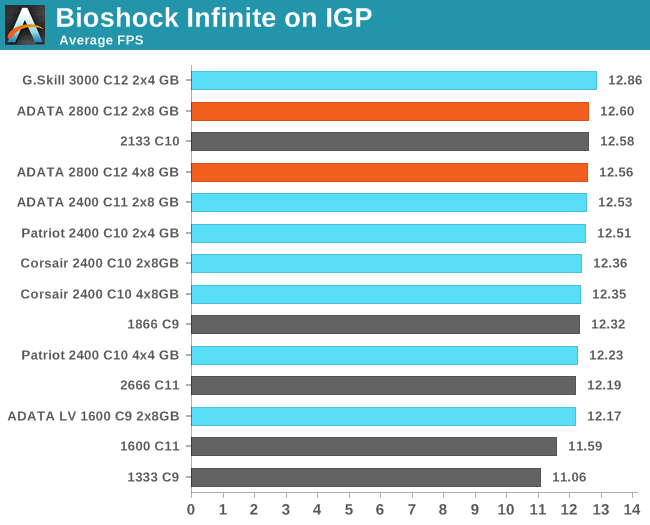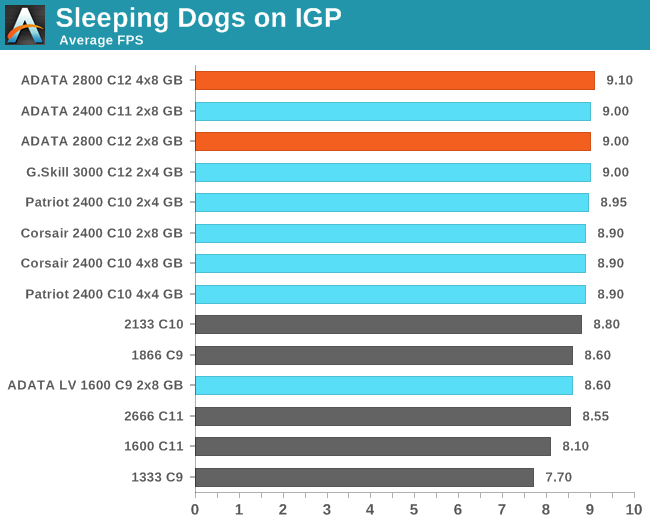ADATA XPG V2 Review: 2x8 GB at DDR3-2800 12-14-14 1.65 V
by Ian Cutress on December 17, 2013 12:00 PM ESTIGP Gaming
The activity cited most often for improved memory speeds is IGP gaming, and as shown in both of our tests of Crystalwell (4950HQ in CRB, 4750HQ in Clevo W740SU), Intel’s version of Haswell with the 128MB of L4 cache, having big and fast memory seems to help in almost all scenarios, especially when there is access to more and more compute units. In order to pinpoint where exactly the memory helps, we are reporting both average and minimum frame rates from the benchmarks, using the latest Intel drivers available. All benchmarks are also run at 1360x768 due to monitor limitations (and produces more relevant frame rate numbers).
Bioshock Infinite:

As expected, a 2800 C12 kit should come near the top for FPS numbers - Bioshock is a little odd in its minimum FPS numbers however, showing a middle of the road result for this kit.
Tomb Raider:

Again this kit hits the higher echelons of Tomb Raider frame rates.
Sleeping Dogs:











19 Comments
View All Comments
Khenglish - Tuesday, December 17, 2013 - link
Your tRFC and tRRD rows are flipped in the table on the first page.That tRFC is ridiculously high. Cut it by 150-200 in XTU (yes, by up to 200. It's that ridiculously high) and you'll see around a 500MB/s bandwidth improvement. For reference I've run 2133 CAS9 stable at tFRC 128 in a laptop.
Also it would be nice to see results on an IVB system as well as Haswell. IVB is just as good at the top end, but I've seen signs that haswell has a better IMC, so while this memory is stable on haswell, it might not be on IVB. Also most people still have an IVB or SB anyway.
Gen-An - Wednesday, December 18, 2013 - link
You can't cut the tRFC by much on these, they use 4Gbit Hynix H5TQ4G83MFR ICs, and especially not at the high clocks they're running. It's going to be over 200 at about any speed, and you pretty much have to run it at 396 or so for 2933.Hairs_ - Tuesday, December 17, 2013 - link
Can we please stop this series of articles now? please?jasonelmore - Tuesday, December 17, 2013 - link
yeah enough with the RAM reviews. we've been on DDR3 for almost 10 years,Jeffrey Bosboom - Tuesday, December 17, 2013 - link
The only explanation I can think of for all these RAM reviews is that in exchange for samples, Anandtech is obligated to provide brand exposure. Otherwise there'd just be one roundup saying "yeah, they're all about the same". If that's the case, I feel sorry for Ian, who surely has better things to do with his time.Navvie - Wednesday, December 18, 2013 - link
This is what I figured, the original article was quite interesting. But this is really scraping the bottom of the barrel for article ideas.DanNeely - Wednesday, December 18, 2013 - link
Gotta agree. At most this should be a twice a year round up; maybe only once yearly depending on how frequently binning changes switch out which clock/cl combinations offer the best bang for the buck.Gen-An - Wednesday, December 18, 2013 - link
Ian, you state these sticks are using Hynix CFR, but CFR is a 2Gbit IC, it'd be impossible to make an 8GB DIMM with them. This has to be Hynix 4Gbit MFR.ceomrman - Tuesday, December 31, 2013 - link
Hmmm... couldn't this article just say "premium RAM is a hoax. Just buy some decent sticks from a known brand with plenty of 4 or 5 Egg reviews, and go with 1866 MHz if your motherboard will support it. Go ahead and buy faster RAM, but don't spend much since the performance impact is not noticeable in the real world."There are zero users who would not benefit more from some other use of the money, either in their savings account or in the form of a bigger SSD, nicer motherboard, more efficient PSU, faster CPU, etc.
Dog + pony show = Blech.